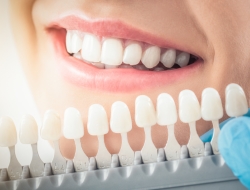What is Gum (Periodontal) Disease?
Infection of the gums is called periodontal, or gum disease. Over time, this disease can destroy the support structure for your teeth. Several types of gum disease exist, and each need a unique treatment approach. The primary cause of gum disease is a buildup of dental plaque. While periodontal disease can have drastic adverse effects on your oral health, regular brushing and flossing your teeth can help prevent much of the possible damage that can occur.
Even if you brush and floss your teeth, you might still have issues with periodontal disease. That’s where routine dental exams come into play. Many modern dental treatments can save your teeth and repair the health of your gums.
Plaque and Cavities
Cavities and plaque cause a buildup of bacteria to form on your teeth and gums. The plaque looks like a film that accumulates on the teeth. Dental patients over the age of 35 are more likely to lose teeth due to periodontal disease than they are due to cavities and tooth decay. Seventy-five percent of all adults experience periodontal issues at some time during their lives.
If you don’t regularly brush and floss your teeth, the plaque that builds up turns to calculus. Calculus contains the bacteria that causes periodontal disease.
In addition to brushing and flossing your teeth daily, you need to have professional dental cleanings and examinations on a schedule recommended by your dentist. Most dentists suggest an exam and dental cleaning every six months. These dental exams and ongoing dental maintenance prevent many types of periodontal disease.
Gingivitis is the inflammatory beginning of periodontal disease. In this gum issue, the gums become inflamed due to the bacteria in the plaque. These bacteria become attached to the surface of your teeth.
If this inflammation isn’t treated, it progresses to periodontitis. Periodontitis becomes a destructive force that destroys the periodontal ligament, can cause tooth loss, and cause alveolar bone destruction.
With treatment and excellent oral hygiene, gum issues remain treatable.
Signs and Symptoms
The first signs and symptoms of periodontal problems include:
- Sore, swollen gums
- Deep red gum tissue
- Sore gums when touched.
- Bleeding after brushing or flossing
- Halitosis (bad breath)
The causes of periodontal disease include poor dental hygiene, infrequent dental care, diabetes, and tobacco use. Pregnant women, people with high blood sugar, and people taking specific prescriptions might tend to have an increased risk for this oral health problem. You might have a higher risk for gingivitis if you:
- Are pregnant
- Take oral contraception medication
- Have high blood sugar or have poorly controlled diabetes
- Take anti-seizure medications, cyclosporin, or calcium channel blockers
People with gingivitis have swollen gums which is caused by the dental plaque/bacteria. Healthy gums remain firmly attached to the teeth and nearby bones. They appear pink if you have light skin or darker in individuals with darker skin. In contrast, individuals with periodontal issues will have significantly darker or redder gum tissue. Your gums may also bleed — bacteria forms around spaces and crevices in the teeth, causing periodontal disease as well as tooth decay.
Reversing Gum Problems
The first step to take to reverse the effects of periodontal disease remains to see your dentist. Your dentist and dental hygienist will evaluate your dental and gum health and clean your teeth. More specific instructions might come from your dentist or hygienist. You’ll get instructions on how to brush and floss your teeth more effectively. Your dentist may also offer suggestions on dealing with medication or physical problems that might increase your chances of periodontal disease.
If you have diabetes, you’ll need to pay extra attention to your oral health and keep your blood sugar at normal levels as much as possible. If you have problems achieving normal blood sugar levels, please see your health care provider for more information on bringing your blood sugar levels within a healthy range.
If you receive a diagnosis of periodontal disease, don’t give up. Please make sure you brush your teeth at least twice per day and floss at least one time daily. Thorough dental cleaning and following your dentist’s advice can go a long way to giving you back the oral health you so richly deserve to have.









